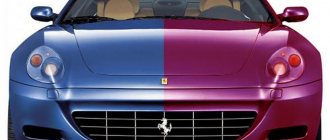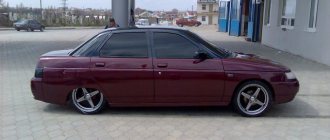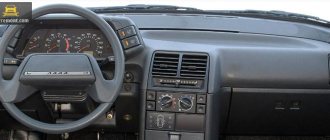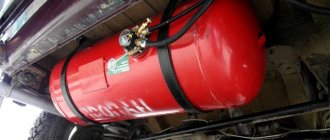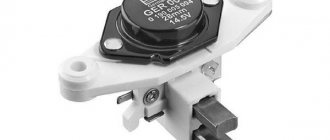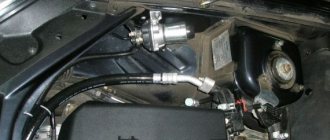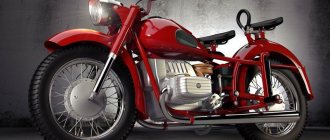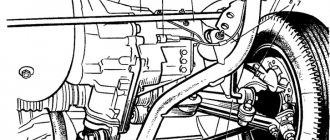Changes to the car compared to its predecessor
In the updated model, not only the external part of the car has radically changed, but the interior has also been significantly updated.
External differences from its predecessor:
- Bumper . The bumper became higher and was painted in body color, like foreign cars; before it, the 10, 11 and 12 models could boast of this.
- Headlights . The headlights became smaller and more rounded, and the optics themselves were quite modern at that time.
- Rear spoiler . Some trim levels were equipped from the factory with a small spoiler that did not differ in color from the car.
- Radiator trim and hood . The hood also differed favorably from its angular predecessor with its rounded shape, which made the 2114's design quite fresh.
- Wings . Slots for turn signals appeared in the wings and, in general, they began to integrate more advantageously into the overall appearance of the car.
- Side skirt fairings . The sills began to be covered with plastic covers and painted the same color as the body.
- Moldings . The moldings go along the doors and are in turn painted to match the color of the car's body.
All this made the VAZ 2114 quite attractive and modern, which, coupled with its low price, promised success for the model. The changes, by the way, did not affect the rear of the car, although initially the engineers planned to change the appearance of the rear lights. The idea was abandoned due to unreasonable increases in production costs.
Looking into the salon, you can find updated:
- Torpedo . The new torpedo was made according to European standards and lost the second glove compartment in the luxury configuration. The plastic has become less creaky than in the nine.
- Dashboard . Although not new, since the instrument panel was already installed on the VAZ 2110, it migrated here, unlike the old one, it had a more modern appearance.
- Steering wheel and steering column . The fourteenth model was equipped with a new, at that time, steering wheel from a VAZ 2110, and a knob for adjusting it appeared on the steering column.
- Seat belt fastenings have found their highest points.
Sitting in the restyled cabin has become much more pleasant and comfortable, and many additional pleasant goodies have appeared, such as:
- electric window lifters;
- heated seats;
- air conditioner;
- fog lights;
- central door locking;
- standard on-board computer;
- alloy wheels and tinting.
There were only two configurations available: basic and luxury. They did not differ much in both price and equipment. The luxury one had a plastic cover on the engine for decoration, a plastic receiver and a standard on-board computer.
In addition, the engineers took care of upgrading the clutch system, gearbox, suspension, braking system and technical equipment in general.
Throughout the history of production, the VAZ 2114 has been equipped with 4 types of engines:
- Having a volume of 1.5 liters, the power of which was 77 horsepower, from 2003 to 2007.
- From 2007 until the moment when the VAZ 2114 was no longer produced, two engine options of the same volume 1.6, with a power of 81 and 90 hp, were installed.
- In 2010, models with updated engines of the same displacement began to appear, but it already had a power of up to 98 hp.
The history of the VAZ 2115
The first prototype of the VAZ 2115 from the Lada Samara family, popularly called “Pyatnashka”, was demonstrated in 1997 at the Moscow Motor Show. From the same year, its serial production was launched. The “Fifteen” differed favorably from its predecessor VAZ 21099 from the Lada “Sputnik” family (year of manufacture 1990) in the design of its front end; the fenders, hood and trunk lid received a more rounded shape. The metal bumper was replaced with a plastic one. The look has become more modern thanks to the side decorative overlays. The trunk, the opening of which began from the bumper, became more convenient. The length of the body increased by 22.5 cm. The car became streamlined and successfully passed tests in the wind tunnel.
How to find out the year of manufacture of a car by marking components
Various parts and mechanisms of the car also carry information about the production date. Let's consider how to find out such information.
Glass
You can find out the month and year of manufacture of the car by the stamps on the windows. Auto glass manufacturers use different branding methods. The year of manufacture is indicated by one digit, which corresponds to the last digit of the calendar year (similar to VIN). Thus, the number “6” can mean 1996, 2006, or 2016. Next you need to be guided by logic. For example, if you know that a given vehicle model was produced from 1998 to 2010. – accordingly, the number “6” will mean the year of manufacture 2006.
The month is indicated by Latin letters (from A to M in alphabetical order) or combinations of dots and (or) slashes.
For clarity, here are a few examples:
- ….6 or 6…. – April 1996, 2006 or 2021;
- 9 ABC or ABC 9 – January 1989, 1999 or 2009 (only the first letter of the three is taken into account).
There are exceptions to the rules. For example, on the windows of Fiat cars, January is indicated by the letter “B”. Accordingly, the designation system is shifted by one position, and December is no longer branded “M”, but “N”.
When determining the production date of a car, it is important to check all the windows. If you find that the markings of individual elements do not match, ask the seller whether the vehicle was involved in an accident, which caused the replacement of one or more glasses.
Safety belt
The date of manufacture of the vehicle is stamped on a label attached to the bottom of each seat belt. Belt fasteners also have similar markings. The designations are simple: day, month and year of issue. Therefore, it will be easy to understand them.
Shock absorber struts on hoods and trunk
Since the mid-90s of the 20th century, on cars from Europe, these components also have markings that make it easy to determine when the car was manufactured. The year of manufacture is indicated in two ways:
- 25/98 (where the first digit is the serial number of the week from 1 to 52, and the second is the year);
- 318/95 (where the first digit is the serial number of the day from 1 to 365, and the second is the year).
Similar markings can be applied to the battery terminals, as well as to the muffler.
The discrepancy between the data on individual components and the production date indicated in the vehicle registration certificate is a good reason to think about the advisability of purchasing it. Often, buyers are faced with the fact that “original” parts have been replaced with new ones for one reason or another. It is impossible to find out exactly the release date of a car from them. Therefore, we still recommend using the all-Russian service “Autocode” for checking.
If you are a professional car seller, use the “Autocode Pro” unlimited car check service. “Autocode Pro” allows you to quickly check a large number of cars, add comments to reports, create your own lists of liquid vehicles, quickly compare options and store data about cars in an orderly form.
https://youtu.be/oaQymIIv3Bk
Modifications
The model had several varieties. Some of the improvements were of a universal optimization nature, while others were intended for specific consumer groups.
Model differences:
- 2101. Model number one had a 1.2 liter engine. A feature of the bumper - “fangs” - were removed in subsequent variations and replaced with rubber gaskets that were located around the perimeter. The reversing light was located under the bumper. In subsequent models it was placed higher. The outside rear view mirror was mounted on the fender, and on subsequent ones - on the driver's side door.
- 21011. The engine was replaced with a 69-horsepower one, that is, more powerful. Engine capacity 1.3 l. For safety reasons, an insufficient brake fluid level sensor was installed. The greatest number of changes affected the body and interior. The radiator grille was designed with large gaps, which was intended to improve air flow to the cooling system. Exhaust openings for cabin ventilation appeared. A full-fledged reversing light has been added. The front seats were also replaced with an improved modification. The car had many cosmetic changes to the interior.
- 21012. Right-hand drive modification of cars intended for export, respectively, to countries with left-hand traffic. The main difference was the strengthening of the spring suspension. The controls, compared to left-hand drive ones, created a greater load on the right side, that is, they changed the ratio of the mass of the left and right sides of the car.
- 21013. Export unit with the engine as in the first model - 1.2 liters. It also received the export name Lada, which was due to the difficulty of foreigners pronouncing the original name of the car brand.
- 21014. Also right-hand drive, with the same gain as in the 21012 model.
- 21015. Modification for the police, also called “Karat”. Such services needed advantages over ordinary car owners, so the engine here was more powerful (1.6 liters), the car was equipped with an additional gas tank, and a reinforced rear suspension. The model also included fastenings for installing the appropriate equipment. Produced in limited quantities.
- 21016. The variation had a general appearance from 2101, while the engine was installed from 21011 (1.3 l)
- 21018. Small-scale version. A VAZ-311 rotary engine (one section) was installed.
- 21019. Also a small-scale version and a more powerful VAZ-411 rotary engine (two-section).
- 2101-94. Equipped with a 1.5 liter engine, the car went into production and was intended mainly for the police, and was also used by more serious intelligence services.
The Lada family got its name due to the fact that for some foreigners the word “Zhiguli” turned out to be difficult to pronounce, and for some it had unfavorable connotations.
Characteristics
Engines
| Name: | 2101 | 21011 |
| Fuel: | Petrol | Petrol |
| Volume: | 1,198 cm3 | 1,294 cm3 |
| Max. power: | 64 l. s., at 5600 rpm | 69 l. s., at 5600 rpm |
| Max. torque: | 87.3 Nm, at 3400 rpm | 94.3 Nm, at 3400 rpm |
| Max. speed: | 137 km/h | 140 km/h |
| Acceleration 0-100 km/h: | 23 sec. | 18 sec. |
Transmission:
| Mechanical: | 4 steps |
| Gear ratios: | |
| 1st gear: | 3,75 |
| 2nd gear: | 2,30 |
| 3rd gear: | 1,49 |
| 4th gear: | 1,00 |
| Reverse gear: | 3,87 |
Dimensions and weight:
| Length: | 4073 mm |
| Width: | 1611 mm |
| Height: | 1382 mm |
| Ground clearance: | 170 mm |
| Wheelbase: | 2424 mm |
| Front track: | 1349 mm |
| Rear track: | 1305 mm |
| Weight: | 955 kg |
This is interesting: How to check the operation of an automatic transmission
Heater radiator - change! The steam outlet fitting is broken.
Heater radiator - change!
The steam outlet fitting is broken. Heater radiator - change! The steam outlet fitting is broken. By the end of the reporting period, the trunk floor presented a problem: its plastic base crumbled into fragments, the carpet turned into a shapeless rag. Based on the prints on the rug, we cut out 5 mm thick hardboard panels and glued them to the upholstery with “liquid nails” - it turned out they didn’t hold! I had to put him on wire braces. The decision was completely justified.
Each kilometer of our “two-wheeler” cost 2.23 rubles. We think it’s acceptable, and in general we’re happy with the car. Although, of course, it’s a pity that the energy and time wasted on numerous repairs.
Final table (click to open full size):
